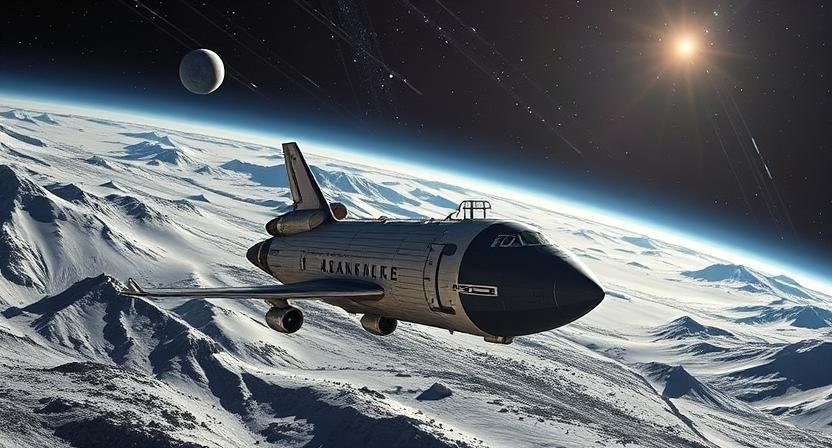The concept of space tourism, once a distant fantasy, has surged into reality with unprecedented momentum. By 2025, the industry is no longer a playground exclusively for billionaires and astronauts—private companies are democratizing access to space, offering suborbital hops, extended orbital stays, lunar flybys, and even plans for interstellar travel. This year marks a turning point as technological breakthroughs, regulatory advancements, and fierce competition converge to make space tourism more accessible, diverse, and ambitious than ever before.
In this blog post, we’ll explore the companies at the forefront of the 2025 space tourism race, their cutting-edge innovations, and how their efforts are reshaping humanity’s relationship with the cosmos.

The Evolution of Space Tourism: From Novelty to Mainstream Ambition
The journey of space tourism began in 2001 when Dennis Tito, a California-based entrepreneur, paid $20 million for an eight-day stay aboard the International Space Station (ISS) via a Russian Soyuz spacecraft. For years, such trips remained rare and exorbitantly priced. However, the rise of private space companies in the 2010s—spearheaded by visionaries like Elon Musk, Jeff Bezos, and Richard Branson—ignited a revolution. Reusable rockets, improved safety protocols, and modular spacecraft designs slashed costs and opened the door to commercial ventures.
By 2025, the industry has matured. Suborbital flights are becoming routine, orbital habitats are under construction, and lunar tourism is inching closer to reality. Ticket prices, while still steep, are falling as competition intensifies. Analysts predict the global space tourism market could exceed $8 billion by 2030, driven by a mix of private adventurers, government partnerships, and scientific collaborations.
The Front-Runners of 2025
Let’s dive into the companies dominating headlines this year, their milestones, and their roadmaps for the future.
1. SpaceX: Redefining Interplanetary Travel
Founder: Elon Musk
Flagship Vehicles: Starship, Falcon 9, Crew Dragon
2025 Focus: Lunar missions, Mars preparation, and orbital tourism
SpaceX remains the undisputed leader in the space industry. In 2025, its fully reusable Starship spacecraft is undergoing rigorous testing, with plans to support NASA’s Artemis program for lunar landings and eventually crewed missions to Mars. However, SpaceX hasn’t forgotten its role in space tourism.
2025 Highlights:
- DearMoon Mission: Yusaku Maezawa’s lunar tourism mission, delayed by earlier technical challenges, is finally slated for late 2025. The week-long trip will carry eight artists and innovators on a circumlunar voyage aboard Starship.
- Orbital Stays: Partnering with Axiom Space, SpaceX is ferrying private astronauts to the ISS and future commercial space stations. Axiom’s third fully private mission, Ax-3, will launch in late 2025.
- Point-to-Point Earth Travel: SpaceX is experimenting with suborbital Earth flights using Starship, promising to slash international travel times to under an hour.
Technological Innovations:
- Raptor 3 Engines: Starship’s upgraded engines improve thrust and fuel efficiency, critical for long-duration missions.
- In-Space Refueling: Successful tests of orbital refueling technology pave the way for deep-space tourism.
Future Goals:
- Establish a permanent lunar base by 2030.
- Offer affordable orbital vacations ($5 million per seat) by the end of the decade.
2. Blue Origin: Making Space Accessible
Founder: Jeff Bezos
Flagship Vehicles: New Glenn, New Shepard
2025 Focus: Lunar landings, space habitats, and eco-friendly tourism
Blue Origin, often seen as SpaceX’s closest competitor, is making strides in 2025 with its New Glenn heavy-lift rocket and ambitious lunar projects. The company’s motto, “Gradatim Ferociter” (Step by Step, Ferociously), reflects its methodical yet bold approach.
2025 Highlights:
- New Glenn’s Debut: After years of delays, the New Glenn rocket completed its maiden flight in early 2025, capable of carrying 45 tons to low Earth orbit (LEO). This vehicle is key to deploying Blue Origin’s proposed Orbital Reef space station modules.
- Lunar Tourism: Partnering with NASA, Blue Origin’s Blue Moon lander will ferry payloads—and eventually tourists—to the Moon’s surface. A crewed test mission is planned for 2026.
- New Shepard’s Resurgence: Following a 2023 grounding due to a launch failure, New Shepard returned to suborbital flights in 2024. In 2025, it’s offering monthly flights, with tickets now priced at 1.2million(downfrom1.2million(downfrom2.8 million in 2021).
Technological Innovations:
- Hydrogen Fuel Cells: New Shepard’s eco-friendly propulsion system reduces carbon emissions.
- Artificial Gravity Stations: Blue Origin is researching rotating space habitats to combat muscle atrophy in long-term tourists.
Future Goals:
- Build a permanent lunar settlement by 2034.
- Reduce suborbital ticket prices to $500,000 by 2030.
3. Virgin Galactic: The Suborbital Experience
Founder: Richard Branson
Flagship Vehicles: VSS Unity, Delta-Class Spaceships
2025 Focus: High-frequency suborbital flights and luxury branding
Virgin Galactic has carved a niche in suborbital tourism, emphasizing the “experience” of space. Its Spaceport facilities in New Mexico and Italy cater to ultra-wealthy clients seeking a blend of adventure and luxury.
2025 Highlights:
- Delta-Class Fleet: The new Delta-class spaceships, unveiled in 2024, enter service in 2025. These vehicles can carry six passengers (up from four) and fly twice weekly, a significant boost from VSS Unity’s monthly cadence.
- Partnerships with Luxury Brands: Collaborations with brands like Rolex and Four Seasons offer curated post-flight experiences, including zero-gravity dining and astronaut training programs.
- Price Adjustments: Tickets now start at 600,000,downfrom600,000,downfrom850,000 in 2023, as economies of scale kick in.
Technological Innovations:
- Hybrid Rocket Motors: More efficient and reusable propulsion systems cut turnaround time between flights.
- Customizable Cabins: Passengers can choose cabin themes, from “Astronaut Explorer” to “Galactic Zen.”
Future Goals:
- Expand to 500 flights annually by 2027.
- Launch a supersonic point-to-point travel service by 2030.
4. Axiom Space: Building the Future of Orbital Living
CEO: Michael Suffredini
Flagship Projects: Axiom Station, ISS Partnerships
2025 Focus: Commercial space stations and research tourism
Axiom Space is positioning itself as the pioneer of orbital real estate. Its Axiom Station, the world’s first commercial space station, is set to begin construction in 2025, with initial modules docking to the ISS before operating independently.
2025 Highlights:
- Ax-3 and Ax-4 Missions: These fully private ISS missions, facilitated by SpaceX’s Crew Dragon, include scientists, filmmakers, and entrepreneurs. Axiom now offers 10-day orbital stays for $55 million per seat.
- Habitat Modules: The first Axiom Station module, featuring luxury sleeping quarters and a Earth-viewing lounge, launches in late 2025.
- Research Partnerships: Pharma giants like Pfizer are funding microgravity experiments, allowing tourists to participate in groundbreaking science.
Technological Innovations:
- Inflatable Habitats: Collaborating with Sierra Space, Axiom uses expandable modules for extra living space.
- Virtual Reality (VR) Integration: Tourists can use VR to simulate Earth environments during long stays.
Future Goals:
- Complete Axiom Station by 2028.
- Offer “space sabbaticals” for corporate teams by 2030.
5. Space Perspective: Luxury Balloon Flights to the Stratosphere
Founders: Jane Poynter and Taber MacCallum
Flagship Vehicle: Spaceship Neptune
2025 Focus: Affordable, eco-conscious near-space experiences
While most companies focus on rockets, Space Perspective offers a gentler approach: a high-altitude balloon ride to the stratosphere. Its Spaceship Neptune capsule provides a 6-hour journey to 100,000 feet, where passengers witness the curvature of Earth against the blackness of space.
2025 Highlights:
- Commercial Launch: After test flights in 2024, Neptune begins commercial operations in mid-2025, with 30 flights planned.
- Lounge-Style Cabins: The capsule features reclining seats, a bar, and a bathroom—amenities absent in rocket-based tourism.
- Ticket Pricing: At $125,000 per seat, Neptune is the most accessible option for near-space tourism.
Technological Innovations:
- Solar-Powered Balloons: Reduced environmental impact compared to rocket launches.
- Biophilic Design: Plant-filled interiors to reduce stress during ascent.
Future Goals:
- Expand to 500 flights annually by 2030.
- Launch a Pacific Ocean-based Spaceport for Asian markets.
6. Boeing: Bridging NASA and Tourism
Flagship Vehicle: Starliner
2025 Focus: ISS resupply and hybrid tourism-science missions
Boeing’s Starliner, despite early setbacks, is finally operational in 2025. While primarily a NASA contractor, Boeing has begun selling seats to private astronauts, blending tourism with critical ISS research.
2025 Highlights:
- Starliner-1 Mission: The first fully private Starliner flight will deliver three tourists and 800 kg of cargo to the ISS.
- Training Programs: Boeing’s Houston-based academy offers a 12-week astronaut training course for tourists.
Future Goals:
- Partner with hotels for pre-flight luxury accommodations.
- Develop a dedicated tourism capsule by 2027.
Emerging Players to Watch
- Rocket Lab: Known for small satellite launches, Rocket Lab plans to offer suborbital tourism via its Neutron rocket by 2026.
- Sierra Space: Its Dream Chaser spaceplane, set for 2026 debut, could revolutionize cargo and crewed missions.
- i-Space (China): The Chinese startup aims to offer lunar rover tours by 2030, leveraging government partnerships.
Challenges and Ethical Considerations
- Safety: High-profile failures (e.g., 2023 New Shepard anomaly) underscore the need for rigorous testing.
- Environmental Impact: Rocket emissions and space debris require sustainable solutions.
- Accessibility: Critics argue that funds could better address Earth’s crises, though proponents highlight spin-off technologies.
The Future of Space Tourism
By 2030, analysts predict orbital hotels, lunar resorts, and even zero-gravity sports leagues. As costs fall, companies may offer financing options, loyalty programs, and themed voyages (e.g., “Northern Lights Orbital Tour”).
Conclusion
2025 is a landmark year for space tourism, blending ambition with tangible progress. While the industry remains in its infancy, the strides made by SpaceX, Blue Origin, Virgin Galactic, and others suggest a future where space is not just a destination but a lifestyle. Whether you’re a thrill-seeker, a scientist, or an investor, the final frontier has never felt closer.


